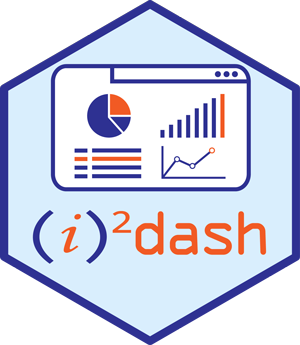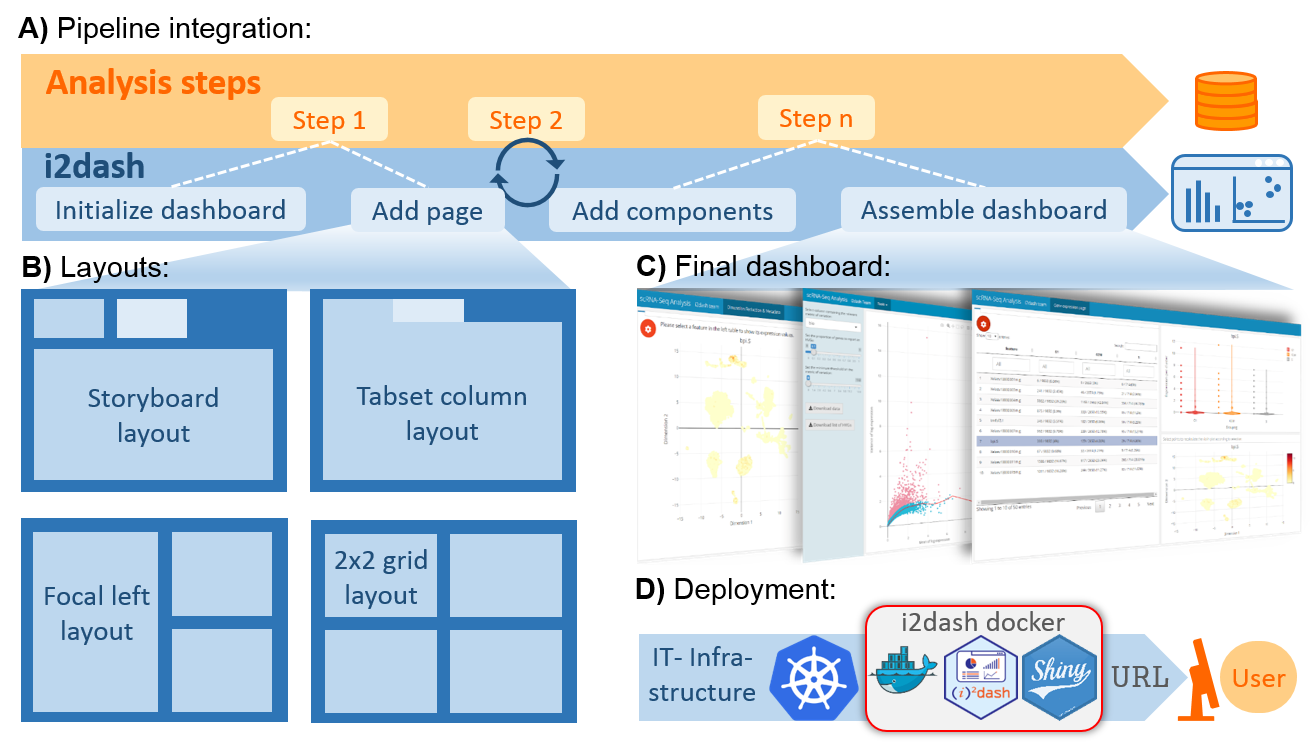Scientific communication and data visualization are important aspects to illustrate complex concepts and results from data analyses. The R package i2dash provides functionality to create customized, web-based dashboards for data presentation, exploration and sharing. i2dash integrates easily into existing data analysis pipelines and can organize scientific findings thematically across different pages and layouts. Ultimately, i2dash supports a wide range of R objects (e.g. 'htmlwidgets') and custom content generating functions as input and therefore integrates well into existing data analysis pipelines.
- Easy integration into existing analysis pipelines in R for programmatic dashboard creation
- Provides a selection of predefined layouts to arrange content
- Support for multiple components, such as htmlwidgets, tables, text, images etc.
- Creation of web-based, sharable, static or interactive dashboards
- Enables a flexible and iterative cycle of dashboard development
(A) dashboard is initialized at the beginning of a data analysis pipeline. During the pipeline run, new content, results, or data visualizations are iteratively added to the dashboard’s pages. The final dashboard is rendered into a static or interactive document. (B) Pages added to the dashboard can be arranged in a flexible manner from a selection of predefined layouts. (C) Examples of programmatically created dashboards. (D) The i2dash docker container, providing all dependencies for interactive, shiny based apps, can be used to easily deploy individual data interpretations on a cloud infrastructure, such as Kubernetes, as a micro service.
The package can be installed with:
install.packages("i2dash")
-
Basics This tutorial gives on overview over the core functions of i2dash and explains how you can build your first dashboard.
-
Custom extension This tutorial teaches how to create custumized and reusable components for i2dash
It is possible to extend the core functionality of i2dash with templates for components and pre-defined pages. This enables to provide an enhanced user interactivity e.g. dynamic change of plot settings. Further, extensions allow an easier integration of complex calculations and data manipulation, hidden behind functions.
- i2dash.scrnaseq enables an enhanced user interactivity and contains simple but effective tools for the creation of an i2dashboard with focus on single-cell RNA-sequencing data visualization and exploration.
At first, install Docker. Then pull the image of i2dash:
docker pull docker.gitlab.gwdg.de/loosolab/container/i2dash.deployment:r3.6.3_bioc3.10
The next step is to run a container and simultaneously load the dashboard files (the .Rmd file and all files of the datadir(dashboard) directory) into the container. To mount custom data into the container, make use of Docker's -v parameter to mount a host directory into the container. Inside the container, i2dash looks for external datasets in /srv/shiny-server/. Use the following code, where you exchange /path/to/dashboard/files with the respective path to the directory containing the .Rmd file and all files of the datadir(dashboard) directory.
docker run -d -p 3838:3838 -v '/path/to/dashboard/files':'/srv/shiny-server' docker.gitlab.gwdg.de/loosolab/container/i2dash.deployment:r3.6.3_bioc3.10
Now, view the dashboard with your browser at 3838:3838.
If you use i2dash or i2dash.scrnaseq in your work, please cite:
i2dash: Creation of Flexible, Interactive and Web-based Dashboards for Visualization of Omics-pipeline Results Arsenij Ustjanzew, Jens Preussner, Mette Bentsen, Carsten Kuenne, Mario Looso bioRxiv 2020.07.06.189563; doi: https://doi.org/10.1101/2020.07.06.189563
This project is licensed under the MIT license.
- The Rmd file of the dashboard contains pages and components but after rendering the dashboard remains empty: Make sure you have a current version of pandoc installed and view the dashboard only with a modern browser.

